
Weimar is a city in the state of Thuringia, Germany. It is located in Central Germany between Erfurt in the west and Jena in the east, approximately 80 km (50 mi) southwest of Leipzig, 170 km (106 mi) north of Nuremberg and 170 km (106 mi) west of Dresden. Together with the neighbouring cities of Erfurt and Jena, it forms the central metropolitan area of Thuringia, with approximately 500,000 inhabitants. The city itself has a population of 65,000. Weimar is well-known because of its large cultural heritage and its importance in German history.

Eisenach is a town in Thuringia, Germany with 42,000 inhabitants, located 50 kilometres west of Erfurt, 70 km southeast of Kassel and 150 km northeast of Frankfurt. It is the main urban centre of western Thuringia and bordering northeastern Hessian regions, situated near the former Inner German border. A major attraction is Wartburg castle, which has been a UNESCO World Heritage Site since 1999.
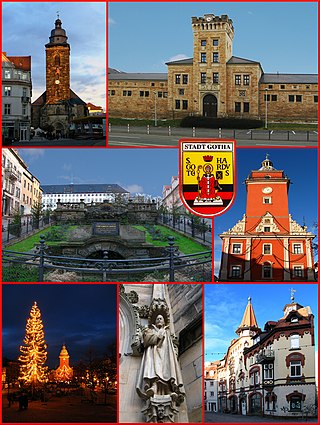
Gotha is the fifth-largest city in Thuringia, Germany, 20 kilometres west of Erfurt and 25 km east of Eisenach with a population of 44,000. The city is the capital of the district of Gotha and was also a residence of the Ernestine Wettins from 1640 until the end of monarchy in Germany in 1918. The House of Saxe-Coburg and Gotha originating here spawned many European rulers, including the royal houses of the United Kingdom, Belgium, Portugal and Bulgaria.
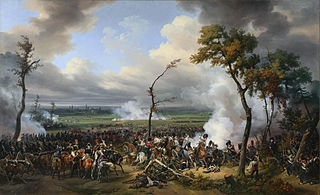
The Battle of Hanau was fought from 30 to 31 October 1813 between Karl Philipp von Wrede's Austro-Bavarian corps and Napoleon's retreating French during the War of the Sixth Coalition.

Upper Lusatia is a historical region in Germany and Poland. Along with Lower Lusatia to the north, it makes up the region of Lusatia, named after the Slavic Lusici tribe. Both parts of Lusatia are home to the West Slavic minority group of the Sorbs.

Oschatz is a town in the district Nordsachsen, in Saxony, Germany. It is located 60 km east of Leipzig and 60 km west of Dresden.
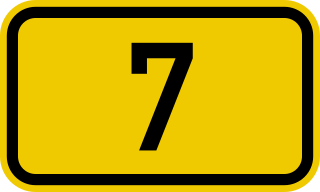
The Bundesstraße 7 is a German federal highway (Bundesstraße) that stretches from the Dutch border at Venlo in the West to Rochlitz near Chemnitz in the East. It is approximately 530 km (330 mi) long. Because of its western origin some stretches of the B 7 are designated as "Holländische Straße", e.g., in Kassel and Calden.
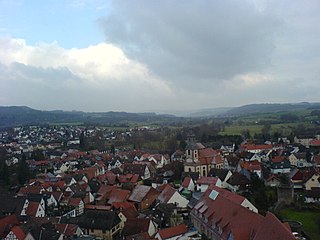
Steinau an der Straße is a town of around 10,000 inhabitants in the Main-Kinzig district, in Hesse, Germany. It is situated on the river Kinzig, 32 kilometres (20 mi) southwest of Fulda. The name Steinau refers to stones in the river; an der Straße, meaning on the road, refers to the historic trade route Via Regia from Leipzig to Frankfurt on which it was located. Steinau is best known for the Brothers Grimm who spent part of their childhood here.

The Bundesstraße 96 is a federal highway in Germany. It begins in Zittau in Saxony, close to the border triangle between Germany, Poland, and the Czech Republic, heads north through Berlin and ends in Sassnitz on the island of Rügen in the Baltic Sea. Some sections of B 96 form a part of the European route E22.

The Bundesstraße 6 is a German federal highway running from Bremerhaven on the North Sea coast in a southeasterly direction through the states of Lower Saxony, Bremen, Saxony-Anhalt and Saxony to Görlitz on the Polish border.
The Halle–Bebra railway, known in German as the Thüringer Bahn, is a 210 kilometre-long railway line from Halle (Saale) via Erfurt and Gerstungen to Bebra, mainly in Thuringia. As far as Gerstungen the line originally belonged to the Thuringian Railway Company. From Gerstungen to Bebra, it was owned by the Frederick William Northern Railway (Friedrich-Wilhelms-Nordbahn), named after the Prussian king, Frederick William IV. It is now a two-track, electrified, standard gauge mainline operated by DB Netze. It was opened between 1846 and 1849 and was the first railway line in Thuringia. All types of trains from Regionalbahn to ICE currently run on the line except Interregio-Express. Four of the six largest cities in Thuringia are located on the line.

The Frankfurt–Göttingen railway is a continuously double track and electrified main line in Hesse and southern Lower Saxony, Germany. The line was initially built from Bebra towards Fulda by the Kurhessen State Railway. After the Prussian annexation of the Electorate of Hesse as a result of the Austro-Prussian War of 1866, it was completed to Frankfurt as the Frankfurt-Bebra Railway. The line was later extended from Bebra to Göttingen.
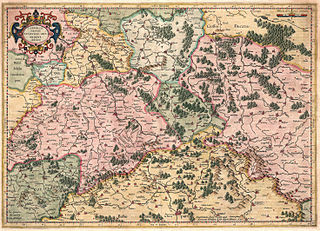
The High Land Road lat. via regia Lusatiae superioris, or strata regia, was a trade route and was one of the Ancient roads. It was a part of the Via Regia, which continued west as far as the Rhine.
The Hanau-Würzburg/Fulda-Erfurt high-speed railway is a collection of railway expansion projects improving capacity and journey times from Frankfurt-am-Main via Hanau to the north and east of Germany.

Offenbach am Main Hauptbahnhof is a railway station serving the German city of Offenbach am Main. It is located on the Frankfurt–Göttingen railway between Frankfurt and Hanau on the south bank of the Main. It is also the starting point of the Rodgau Railway, via Obertshausen, Rodgau and Ober-Roden to Dieburg.

The Bundesstraße 87 is a Bundesstraße in Germany. It begins in Ilmenau and ends in Frankfurt (Oder). In Thüringia it runs partly along the Straße der Romanik.
Johann Karl Wilhelm Voigt was a German mineralogist and mining engineer.
The Brabant Road, Cologne to Leipzig Road or Liege Road is an ancient road which, during the Middle Ages and Early Modern Period, was one of the most important continental east-west oriented military and trade routes. It ran from the eponymous Duchy of Brabant to Leipzig.

















